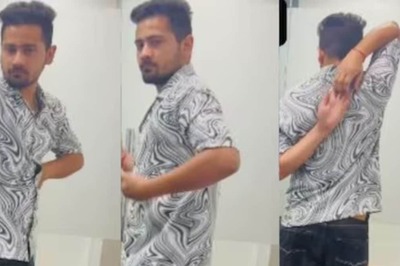
views
The Different Types & Styles of Braids
Box braids Box braids are a protective style of textured or natural hair. This style of braid is edgy, cool, and grows with your hair. The versatility of box braids also means you can do multiple styles with them! You can braid box braids, pull them back into a ponytail, or decorate them with charms. History: Box braids originated in South Africa and have been worn and styled since 3500 B.C. Because these braids can take up to 8 hours to create, many associated the braids with wealth and status. Level: Easy How to do it: Check out this easy tutorial!
Micro braids Micro braids (also known as zillion braids) are a protective hairstyle for natural hair. These braids are made using a similar technique to box braids. The difference? They’re formed with even smaller strands of hair. Think of micro braids as tinier versions of box braids. They can be worn half-up and half-down, in a high ponytail or bun, or even curled with a curling iron. History: Micro braids date back to 35000 BCE and were worn to convey social, tribal, and marital status. Level: Moderate How to do it: Follow this step-by-step tutorial.
Cornrow braid Cornrows are intricate braids formed at the scalp in narrow, parallel strips along the head. The look is not only elegant but versatile. Cornrows can be styled up or down and decorated with charms or colored locks. These braids are traditionally styled in natural or textured hair, but can also be worn in fine or thin hair. History: Cornrows date back to 3000 B.C. Africa. Traditionally, the pattern of cornrows indicated the tribe and status of the wearer. Level: Moderate How to do it: Take a look at this beginner-friendly tutorial.
Knotless braid Knotless braids are a more natural, lightweight version of box braids. Unlike box braids, these braids are formed without knotting the hair at the scalp. Knotless braids start by feeding the wearer’s hair into the braid at the scalp. This style of braid has the same edge, elegance, and versatility as box braids, but without the pain and heaviness. History: Knotless braids evolved from traditional box braids in the early 2000s. Level: Hard How to do it: Check out this simplified tutorial!
Goddess braid Goddess braids are raised, defined braids with an elegant design. While similar in appearance to cornrows, Goddess braids are thicker. The braids are formed close to the scalp and typically drape down the wearer’s shoulders. Goddess braids have their name for a reason: they’re outrageously gorgeous! History: Goddess braids originated in Ancient Africa and have a similar history to cornrows. Level: How to do it: Check out this step-by-step tutorial.
Ghana braid Like cornrows, Ghana braids are formed close to the scalp. But what sets these braids apart is their intricate designs. Ghana braids start small then move into a larger pattern that tapers off toward the end. This gives the braids an edgy, royal-esque look. History: Ghana braids originated in Africa and have played a big part in Ghanaian culture and traditions since then. Level: Moderate How to do it: Take a look at this tutorial.
Stitch braids Stitch braids are a version of cornrows that “feed-in” sections of hair. This natural braiding style is done in intervals that create linear patterns across the scalp. Being tightly woven and evenly spaced, stitch braids have a regal and ethereal look. History: Stitch braids evolved from cornrows and are believed to have originated in Africa. Level: Hard How to do it: Stitch braids follow a similar technique to cornrows, but require a tighter, smaller weave completed in complex, uniform sections.
Three-strand braid The 3-strand braid is the most traditional style of braid—it’s likely what you imagine when you think of the word “braid.” This is the classic way to braid, weaving 3 strands of hair together to form a plait. A 3-stranded braid can be worn multiple ways to achieve multiple looks. From soft and ethereal to messy and edgy, anything’s possible! History: Braids are deeply rooted in African history and culture. Being the most traditional form of braid, many believe the 3-stranded braid originated in Africa. Level: Easy How to do it: Learn how to do a traditional braid with this guide.
French braid French braids are an elevated version of the traditional 3-stranded braid. This braid is formed at the scalp by integrating more hair into each strand with each weaving motion. Worn up, down, or messily, French braids are incredibly versatile and give the hair a woven look. History: The exact origins of the French braid are unknown. Despite its name, it’s strongly believed that the French did not create this style; rather, the Greeks and Africans did. Level: Easy How to do it: Take a look at this beginner-friendly guide. There are multiple versions of French braids, including a French lace braid, which doesn’t connect the braid to the scalp.
Dutch braid Dutch braids are the inverse of French braids—to Dutch braid, you cross hair under one another. This braided style interweaves the hair to create a raised braid along the scalp, giving an edgier look. Like French braids, Dutch braids can be worn down, up, or in pigtails. But while the two styles of braids have similar weaving techniques, the Dutch braid has a bolder, edgier look. History: Despite their name, Dutch braids didn’t originate in the Netherlands. In fact, this braided style was created in Africa over 5,000 years ago. Level: Moderate How to do it: Learn how to do this braid style here.
Fishtail braid Fishtail braids put a playful spin on a traditional 3-stranded braid. This braid integrates sections from two sections of hair, interweaving them to create a scallop-like design. Fishtail braids are often worn over the shoulder, but they can also be worn in a half-up, half-down look. History: Fishtail braids date back to Ancient Athens in 430 BCE, where maidens would wear them to allude to their high societal status. Level: Moderate How to do it: Follow this beginner-friendly tutorial!
Waterfall braid The waterfall braid is a braided half-up, half-down hairstyle that’s fun and elegant. This braid looks intricate, but it’s actually really easy to do! It uses a weaving technique similar to the French braid but leaves out one side, creating a “waterfall effect.” History: The exact origins of the waterfall braid are unknown, but it’s believed to be an evolution of the French braid. Level: Easy How to do it: Take a look at this easy guide.
Crown braid The crown braid is a braided hairstyle that looks complex but is super easy to achieve. This style can be messy or elegant, depending on the wearer’s choice. All it consists of is a traditional 3-stranded braid wrapped up and over the forehead, like a crown. With a few bobby pins and some hairspray, almost anyone can achieve this fun look! History: Crown braids are believed to have started in Ancient Rome, where they were a symbol of high or noble status. Level: Beginner-friendly How to do it: Take a look at these tutorials for different variations of crown braids. Crown braids can be made with almost any style of braid! Some like to wrap longer French or Dutch braids around the scalp.
Milkmaid braid The milkmaid braid is almost identical to the crown braid. So, what’s the difference? Instead of the braid being positioned over the crown or forehead, it rests in the middle of the head. This creates a classic yet intricate look that keeps the hair out of the face and off the neck. History: While the origins of milkmaid braids are unknown, they’re known to have been popular in medieval times around the 16th and 17th centuries. Level: Beginner-friendly How to do it: Follow this easy tutorial! Like crown braids, milkmaid braids can be done with various braids; however, traditionally, they’re made with a 3-stranded braid.
Halo braid The halo braid is almost an exact copy of the crown braid. The difference? It’s typically done with a Dutch braid. This braided hairstyle features one or more Dutch braids wrapped around the crown of the head, creating a halo effect. The braids are usually stacked on top of one another for added height and dimension. History: The origins of the halo braid are unknown, but it’s believed to be an evolution of the crown braid, which originated in Ancient Rome. Level: Moderate How to do it: Follow this beginner-friendly tutorial.
Rope braid Rope braids are quick, easy, and stylish. These braids require no weaving and only 2 sections of hair. When the 2 sections are twisted together, they create a rope shape that’s edgy and playful. This style of braid can be worn in half-up, half-down looks or on its own for a more sophisticated look. History: While the origins of the rope braid are unknown, it’s believed that the idea for the style came from following a similar binding technique with rope and/or thread. Level: Beginner-friendly How to do it: Check out this easy tutorial! EXPERT TIP Amber Rose Amber Rose Licensed Cosmetologist Amber Rose is a Licensed Cosmetologist and the Founder and Owner of Quality Style Weaves and Braids Salon in Orlando, Florida. With over ten years of experience, Amber is experienced in twists, braids, weaves, cutting, styling, and conditioning treatments. She specializes in hair growth for all hair types. Amber Rose Amber Rose Licensed Cosmetologist Make sure your hair is straight when doing rope braids. Rope braids work best on straight hair, so blow-dry your hair straight before styling. Curly or frizzy hair can make it more difficult to see the rope braid pattern.
Pigtail braids Pigtail braids are a braid hairstyle that features 2 braids worn on either side of the head. This look can be achieved with practically any braid type—3-stranded, French, Dutch, cornrows, you name it! The braids can be worn down the scalp and over the shoulders or up at the top of the head, flaring out. History: It’s uncertain when the pigtail braids first appeared, but they became increasingly popular in the late 17th and 19th centuries. Level: Easy How to do it: Follow this tutorial for a cute pigtail braid style.
Loop braid Loop braids are a fun and sassy spin on pigtail braids. This braided hairstyle is created with 2 high or low ponytails. The ponytails are braided in a rope or 3-stranded style, and then looped back up to the top of the ponytail. Loop braids aren’t commonly seen, but when they are, they’re a showstopper! History: Loop braids became popular in the mid-2000s. Level: Easy How to do it: Create 2 ponytails, braid them, and then bring the ends of the braids up to the top of the ponytails, securing in place with bobby pins or hair elastics.
Bubble braid Bubble braids (also known as popcorn braids) are essentially ponytails with multiple elastics. This “braided” hairstyle requires no braiding or weaving whatsoever! All you have to do is create a ponytail and line the hair with evenly spaced hair elastics. This creates a fun, playful look perfect for concerts or parties. History: Bubble braids are a traditional protective hairstyle for natural hair, but they started becoming more mainstream in 2023. Level: Beginner-friendly How to do it: Follow this easy guide!
Frequently Asked Questions About Braid Types
How many types of braids are there? There are hundreds, if not thousands, of braid styles out there! Every year, braiders get more and more creative, inventing new designs and styles from existing braids. The history of braids is vast, and there’s no telling just how many types and styles are out there. There are certainly the main kinds (such as listed in “The Different Types & Styles of Braids”), but there are also so many variations.
What type of braid is the easiest? The easiest type of braid is arguably the rope braid. This braid requires no weaving or plaiting whatsoever—you just have to twist sections of hair together! The easiest traditional braid style would be a 3-stranded braid, which uses the basic weaving technique for most braid styles.
What is the hardest type of braid? The hardest type of braid depends on your confidence level when it comes to braiding. However, arguably the most challenging style of braid is a woven braid, which combines multiple braiding patterns and styles to create an intricate design. Let’s put it this way: Woven braids are so difficult that we didn’t even include them in this article!
What is the most popular type of braid? The most popular type of braid is a French braid. This is arguably one of the most versatile braids and can be done on natural, textured, and fine hair. Keep in mind that this is only a matter of opinion. While most of the internet says French braids are the most popular, you might think differently, and that’s okay!
What type of braids last the longest? Box braids, French braids, and fishtail braids typically last the longest. These braids can usually be worn for hours (or days) without budging, depending on your hair type and activity levels. Want to make your braided hairstyle last? Check out this article on how to set and maintain your braids. EXPERT TIP Ndeye Anta Niang Ndeye Anta Niang Hair Stylist & Master Braider Ndeye Anta Niang is a Hair Stylist, Master Braider, and Founder of AntaBraids, a traveling braiding service based in New York City. Ndeye has over 20 years of experience in African hair including braiding box braids, Senegalese twists, crochet braids, faux dread locs, goddess locs, kinky twists, and lakhass braids. Ndeye was the first female of her tribe in Africa to move to America and is now sharing her knowledge of African braids passed on from generation to generation. Ndeye Anta Niang Ndeye Anta Niang Hair Stylist & Master Braider Prepare your hair before braiding it. Before braiding your hair, give it a good shampoo and deep conditioning treatment. Detangle and dry each section of hair thoroughly to ensure the strands don’t tangle while braiding.
How do you know what type of braid suits you? Consider your face shape, hair type, and lifestyle when picking a braid. If you’re not sure which style of braid to choose, here are some tips to ensure you pick the best braid for you: Face shape: Certain braids can help elevate your natural features. Determine your face shape, and choose a braid style accordingly: Oval faces look great in any style of braid. Round faces look best in braids with volume, like crown braids. Square faces look great in side-swept braids with loose face-framing pieces. Heart-shaped faces look best in side braids or waterfall braids. Hair texture: If your hair is straight and fine, aim for simple styles that can be secured with mousse or hairspray. Curly and thick hair can hold more intricate styles, like box braids. Lifestyle: Braids are typically low maintenance, but natural styles (cornrows, micro braids, etc.) may require a different hair care routine. Opt for a braid that matches your current needs. Will you need to take the braid out right away? Is it a style you want long term? At the end of the day, go with a braided style you like! If you feel confident, it’s sure to shine through.


















Comments
0 comment